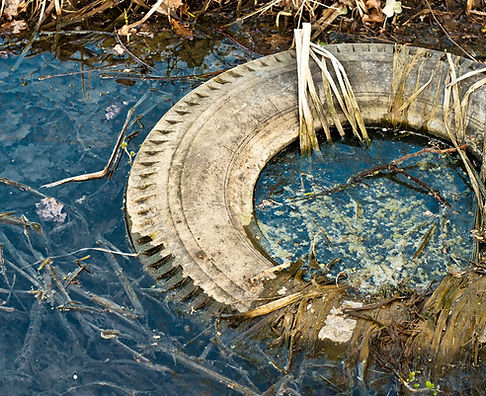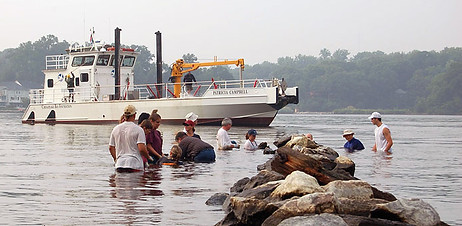
The River City
Throughout the James River and Chesapeake Bay Watersheds there are various organizations working together to promote and preserve our local aquatic environments. Listed below are the many non-profits, private business and government agencies for the James and its tributaries. Looking to help the cause? Follow our link to the 'Volunteer' page

Government Agencies
The Virginia Department of Environmental Quality
Virginia's DEQ follows a strategic plan with the objective of achieving focused, more efficient programs to meet or exceed environmental standards. DEQ's programs span numerous fields in order to provide cleaner water available for all uses, improved air quality that supports communities and ecosystems, and the productive re-use of contaminated land. Significant efforts have been taken and resources expended throughout the 64,000 square-mile Chesapeake Bay watershed to restore the water quality and living resources of the Bay.
DEQ works with other state agencies, local governments and citizens through its Chesapeake Bay office in these general areas: nutrient point source reduction, toxic substance reduction, a monitoring program and other goals set out in the Chesapeake Bay Watershed Agreement. Furthermore, as part of a larger effort to protect water quality under the DEQ Water Division, the DEQ also focuses efforts on protecting wetlands and streams and their beneficial uses.
Other Governmental/ Political Agencies:




Non-Profits


Chesapeake Conservancy is a non-profit organization based in Annapolis, Maryland, dedicated
to ensuring a healthier Chesapeake Bay watershed where fish and wildlife thrive, and everyone enjoys healthy waters and abundant forests, wetlands, shorelines, and open spaces. The Conservancy serves as a catalyst for change, advancing strong public and private partnerships, developing and using new technology, and driving innovation throughout their work. The
Initiatives launched by the James River Association, such as cleanups and rallies, seek to conserve non-developed land on and around the James to preserve its health. JRA takes action to promote conservation and responsible stewardship of its natural resources through its core programs: Watershed Restoration, Education, Outreach, River Advocacy, and the Riverkeeper program. Recently, JRA has partnered with other organizations to connect the public to the James RIver through virtual paddle tours. Furthermore, JRA has been collecting
Conservancy works in close partnership with the National Park Service Chesapeake Bay Office, the United States Fish and Wildlife Service, as well as other federal, state and local agencies, private foundations, and corporations to advance conservation.
and analyzing river data in order to formulate a more complete picture of the health of the James. JRA continuously engages with active citizens in order to achieve the best possible state of our founding river.
Public Agencies
Southern Environmental Law Center
For 30 years, the Southern Environmental Law Center has used the power of the law to champion the environment of the Southeast— the fastest growing region of the U.S. The SELC team of 70 dedicated attorneys stands up for all the things you love about this special region—clean water, clean air, mountains, forests, the coast. Through issue-based regional programs, this organization aims to do nothing less than shape the future of our six states. SELC’s positive vision for the South includes a healthy environment, a strong economy, and vibrant cities and towns throughout the South. Recently, SELC has partnered with the JRA to combat water pollution in Richmond. Working with SELC, the James River Association says they will challenge a permit issued by the Virginia Department of Environmental Quality to Dominion Virginia Power last month, which will allow the discharge of 350 million gallons of coal ash pond water into the James River. SELC is a consistent voice for one of the most beautiful and biologically diverse regions in the world. They truly play a major role in defining the environmental future of the South.
Other Non-Profits


Virginia Recreation and Park Society
The Virginia Recreation and Park Society is a private, non-profit professional organization, founded in 1953 and incorporated in 1956. Its purpose is to unite all professionals, students, and interested lay persons engaged in the field of recreation, parks and other leisure services in the Commonwealth of Virginia, into one body. The members work together to promote and improve the profession in all its diversity. VRPS is affiliated with the National Recreation and Park Association. VRPS has both inward and outward facing goals: 1) provide and encourage continuous training opportunities for members and 2) improve recreation, parks, and leisure services to the public. Workshops, conferences, and involvement at committee and board levels provide valuable training and the opportunity to see what other people in leisure services are doing. While helping out many of the governmental agencies listed above, VRPS also helps its members find careers in these fields.
Public Organizations
Other Public Organizations:



Department of Conservation & Recreation
The Virginia Department of Conservation and Recreation (DCR) focuses its efforts on providing individuals, businesses and communities the tools and information needed to make wise decisions in conserving our natural and recreational resources. While the DCR's work falls into numerous categories, it primarily manages, protects and provides access to numerous state parks throughout the commonwealth. The beautiful trails, scenic beaches, and convenient access points to the state's major waterways attract about 8 million visitors a year. The DCR is also deeply invested in science-based research through its Natural Heritage Program. Scientists collecting data on natural communities and rare plants and animals are working to protect Virginia's native plant and animal life and the ecosystems upon which they depend. In 1994, 2006 and again in April 2016, The Virginia Natural Heritage Program was recognized by NatureServe as the outstanding natural heritage program in the western hemisphere.

Local Initiatives
The Richmond Riverfront Plan, adopted by Richmond City Council in November 2012 as a part of the City's Master Plan and Downtown Plan, is the City’s comprehensive vision for the Riverfront. The plan covers both sides of the James River from Belle Isle to Rockett’s Landing and outlines steps for the improvement of our Riverfront as a single unified, cohesive space. The Riverfront Plan's main goals are to establish priorities for the Riverfront and outlin potential mechanisms for management of this unique place in our city. Other main facets of the plan include: building the new non-motorized T. Tyler Potterfield Memorial Bridge near the current Manchester Bridge, creating more access to Chapel Island and building terraces to line the downtown river front. To learn more about both Richmond's Master Plan and Riverfront Plan, click here.

CBF's oyster restoration programs offer citizens the tools and information needed to help restore native oysters, Crassostrea virginica, to the Chesapeake. Until the 1980s, oysters supported the most valuable fishery in the Bay. Today, as a result of decades of pollution, overharvesting, and disease, the Bay's native oyster population has been estimated at as low as one percent of historic levels. Yet oysters remain a keystone species in the Bay's ecology. They filter algae, sediment, and other pollutants and in the process improve water quality and clarity. Their large reefs provide habitat for fish, crabs, and other Bay organisms. Restoration is critical to help improve the Bay's water quality and increase its economic viability.

Through "Grasses for the Masses," CBF engages local Virginians to help stabalize the Bay's underwater ecosystem. Participants in the program grow wild celery (Vallisneria americana), a type of underwater grass, in a simple grow-out system in their homes for 10-12 weeks. After 10-12 weeks of grow-out, participants will gather to plant their grasses in select local rivers to bolster grass populations and help restore the Bay. By providing both the instructions and the tools necessary to grow the underwater grasses at home, CBF is putting the health and lifespan of the Bay in the hands of its inhabitors.
The Chesapeake Bay Foundation (CBF) is the independent conservation organization dedicated solely to saving the Bay. CBF serves as the guardian of the Chesapeake, fighting for effective, science-based solutions to the pollution degrading the Bay and its rivers and streams. Below we have highlighted just two of CBF's many intiatives to protect and serve all the unique ecosystems of the Chesapeake and its tributaries.


Volunteers plant wild celery in the James River as part of CBF's Grasses for the Masses program. Photo by CBF Staff
Volunteers plant young oysters on an oyster reef. Photo by CBF Staff
Other Local Initiatives:
In 2011, the James River Association and the Chesapeake Conservancy partnered with National Geographic Maps to establish Envision the James. Envision the James (ETJ) is an on-going conservation initiative that works with communities and partners in the James River watershed to plan and implement projects that sustain and enhance the region’s natural and cultural heritage, local economies, wildlife abundance, and outdoor recreation assets for present and future generations.

